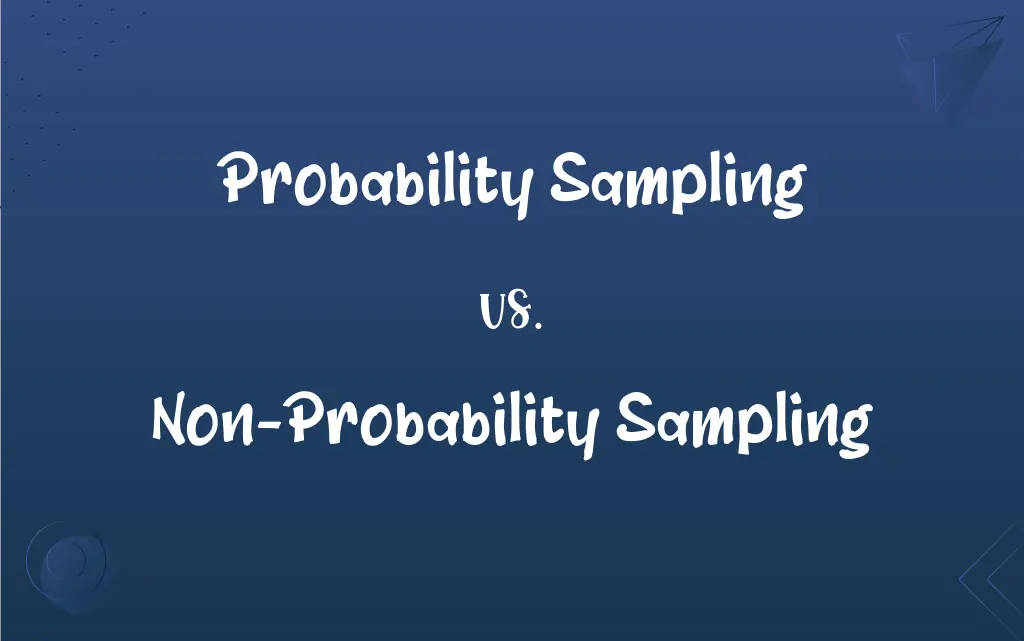Probability Sampling vs. Non-Probability Sampling: What's the Difference?
Edited by Aimie Carlson || By Harlon Moss || Updated on October 5, 2023
Probability sampling involves random selection, while non-probability sampling doesn’t ensure every member equal chance of selection. Difference: randomness in selecting samples.

Key Differences
Probability sampling encompasses various techniques that incorporate randomness and impartiality in the selection process. This methodological choice ensures that every member of the population has an equal chance of being chosen, which aids in generating representative samples and generalizable results. In contrast, non-probability sampling methods do not give equal chances to all members, as selection is often based on convenience or specific criteria, which can lead to biases and limit generalizability.
Under the umbrella of probability sampling, researchers might employ strategies like simple random sampling, systematic sampling, or stratified sampling. These techniques, while differing in approach, uphold the principle of random selection, thereby aiming to reduce sampling bias and enhance the reliability of collected data. In opposition, non-probability sampling may adopt approaches like quota sampling or convenience sampling, which, by their nature, don’t assure randomness and may introduce various biases, which researchers must acknowledge when interpreting findings.
An integral aspect of probability sampling is its affinity for quantifiable sampling error, which can be calculated due to the random nature of sample selection. This error helps researchers to estimate the accuracy of their results and, thus, lend them a degree of statistical credibility. On the flip side, non-probability sampling lacks this attribute, meaning researchers cannot determine the sampling error, which may hinder the statistical validation and accuracy of results.
Furthermore, probability sampling generally necessitates a comprehensive sampling frame, which might not always be available or feasible to obtain for all research scenarios. This stringent requirement is alleviated in non-probability sampling, which allows researchers to conduct studies even in the absence of a complete sampling frame, providing practicality in certain research contexts, albeit with acknowledged limitations regarding representativity and generalizability.
Conclusively, probability sampling and non-probability sampling cater to different research needs and contexts, with the former offering a pathway to statistically credible and generalizable findings, and the latter offering practical and often more feasible options, especially in exploratory or qualitative research phases.
ADVERTISEMENT
Comparison Chart
Basis of Selection
Random
Non-random
Generalizability
High (due to random selection)
Often limited
Ability to Calculate Sampling Error
Yes (enables confidence intervals and hypothesis testing)
No
Requirement of a Sampling Frame
Usually required
Not necessarily required
Examples
Simple Random Sampling, Stratified Sampling
Convenience Sampling, Quota Sampling
ADVERTISEMENT
Probability Sampling and Non-Probability Sampling Definitions
Probability Sampling
Probability sampling allows equal selection chance to every population member.
To ensure fairness in a lottery, organizers used probability sampling, giving each ticket an equal winning chance.
Non-Probability Sampling
Non-probability sampling is practical in exploratory phases of research.
In preliminary stages, researchers used non-probability sampling for practicality and speed.
Probability Sampling
Probability sampling can involve various methods like stratified or systematic sampling.
The election poll used stratified probability sampling to fairly represent all age groups in the survey.
Non-Probability Sampling
Non-probability sampling often relies on convenience or purposive methods.
The researcher opted for non-probability sampling, choosing subjects readily accessible to him.
Probability Sampling
Probability sampling aims for representativeness through random selection techniques.
In clinical trials, probability sampling ensures varied participants, enhancing the study’s generalizability.
Non-Probability Sampling
Non-probability sampling cannot quantify sampling error.
With non-probability sampling in the pilot study, calculating a sampling error was unattainable.
Probability Sampling
Probability sampling enables the computation of sampling errors.
Researchers appreciated probability sampling for allowing them to estimate the margin of error in the study.
Non-Probability Sampling
Non-probability sampling might exhibit biases due to non-random selection.
Critics argue that non-probability sampling in the study might have introduced selection bias.
Probability Sampling
Probability sampling utilizes random methods to choose samples.
The survey used probability sampling to randomly select residents from different areas for unbiased results.
Non-Probability Sampling
Non-probability sampling doesn’t guarantee every member an equal selection chance.
The focus group used non-probability sampling, selecting participants available on short notice.
FAQs
What is probability sampling?
Probability sampling is a sampling method where every member of the population has a known, non-zero chance of being selected.
Is probability sampling free from bias?
It minimizes bias but does not eliminate it entirely.
Name a few types of probability sampling.
Examples include Simple Random Sampling, Stratified Sampling, and Cluster Sampling.
How does cluster sampling work?
The population is divided into clusters, and some clusters are randomly chosen.
Why use non-probability sampling?
It's often used when probability sampling is impractical due to resource constraints or the nature of the research.
When is quota sampling useful?
Quota sampling is useful when the researcher wants to ensure specific subgroups are represented.
Is non-probability sampling scientific?
While it can be systematic and purposeful, it lacks the statistical rigor of probability sampling.
Is non-probability sampling more suitable for qualitative or quantitative research?
It's often used in qualitative research but can be used in certain quantitative studies where representativeness is not critical.
Is probability sampling feasible for all research?
No, it may not be practical for all studies due to resources, time, or accessibility.
What is non-probability sampling?
Non-probability sampling involves selecting samples without providing every member of the population a known chance of inclusion.
What is purposive sampling?
Purposive sampling involves selecting participants based on specific characteristics or qualities.
Can non-probability sampling be biased?
Yes, it can introduce bias as not all members of the population have a chance of selection.
Why is it called 'probability' sampling?
Because it relies on the principles of probability to select samples.
How is simple random sampling conducted?
Each member of the population has an equal chance of being selected, often using random number generators.
What is stratified sampling?
Dividing the population into subgroups (strata) and selecting samples from each subgroup.
In which scenarios is probability sampling most appropriate?
When a representative sample is required, and resources permit random selection.
Can probability sampling be used in qualitative research?
Yes, though it is more commonly associated with quantitative research.
Mention some types of non-probability sampling.
Examples include Convenience Sampling, Quota Sampling, and Purposive Sampling.
Can non-probability samples be generalizable?
Generally, they have limited generalizability due to potential sampling biases.
Describe convenience sampling.
Sampling involves choosing participants who are readily available or easy to reach.
About Author
Written by
Harlon MossHarlon is a seasoned quality moderator and accomplished content writer for Difference Wiki. An alumnus of the prestigious University of California, he earned his degree in Computer Science. Leveraging his academic background, Harlon brings a meticulous and informed perspective to his work, ensuring content accuracy and excellence.
Edited by
Aimie CarlsonAimie Carlson, holding a master's degree in English literature, is a fervent English language enthusiast. She lends her writing talents to Difference Wiki, a prominent website that specializes in comparisons, offering readers insightful analyses that both captivate and inform.
































































